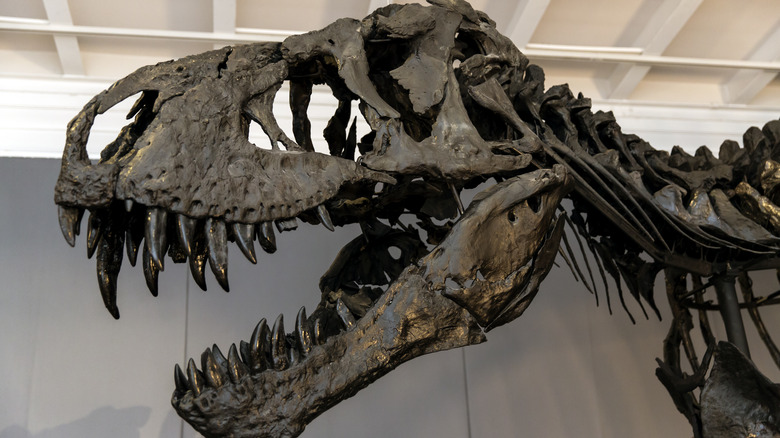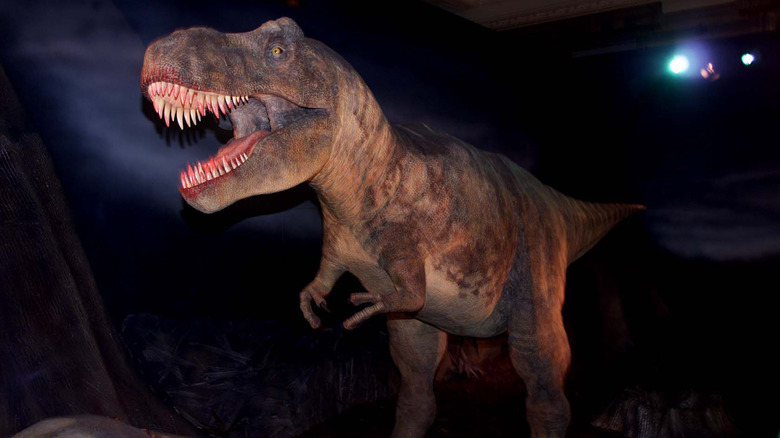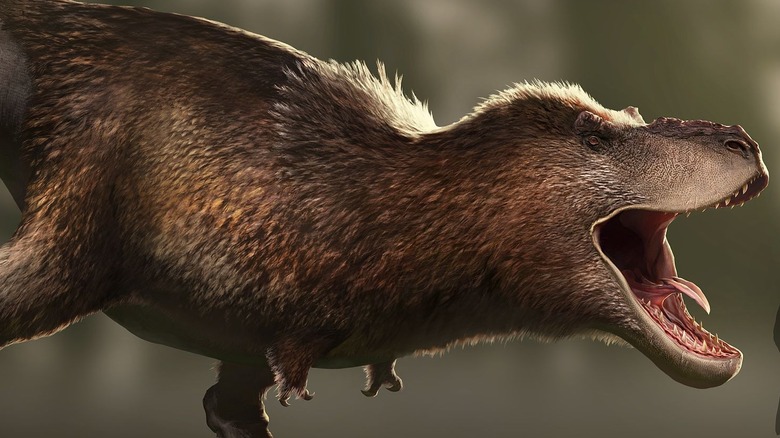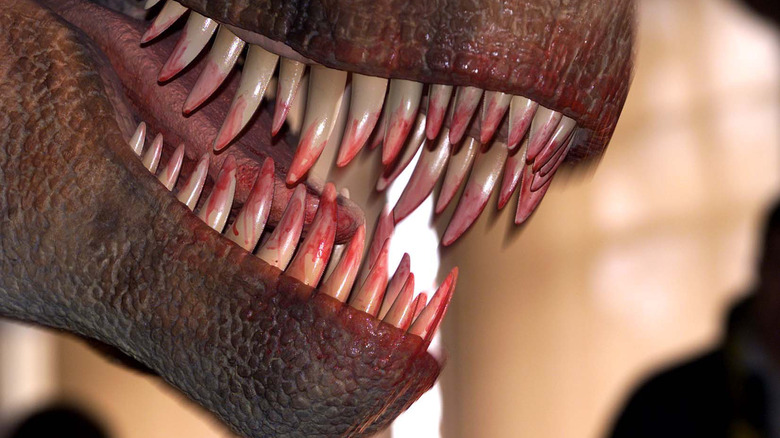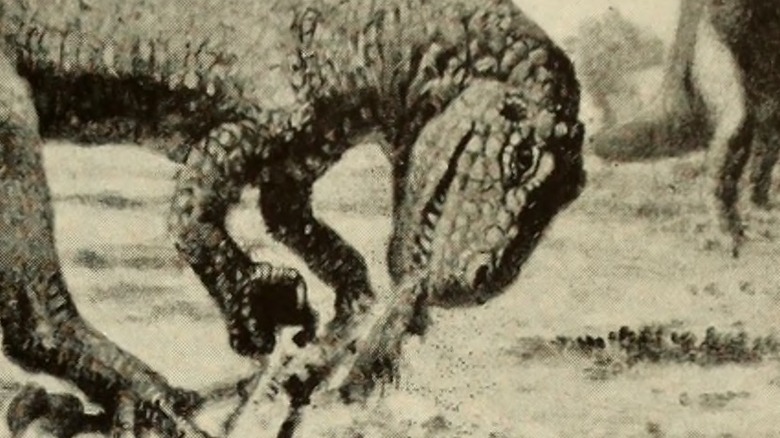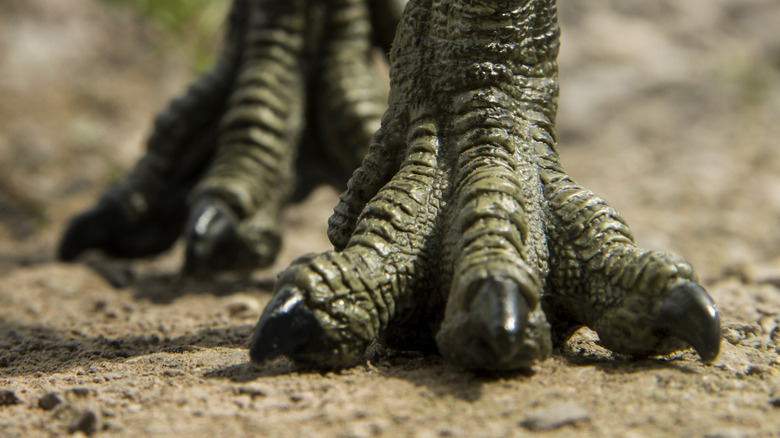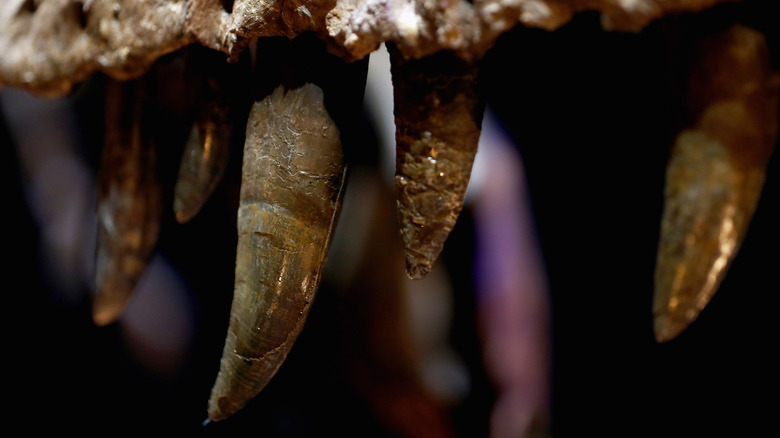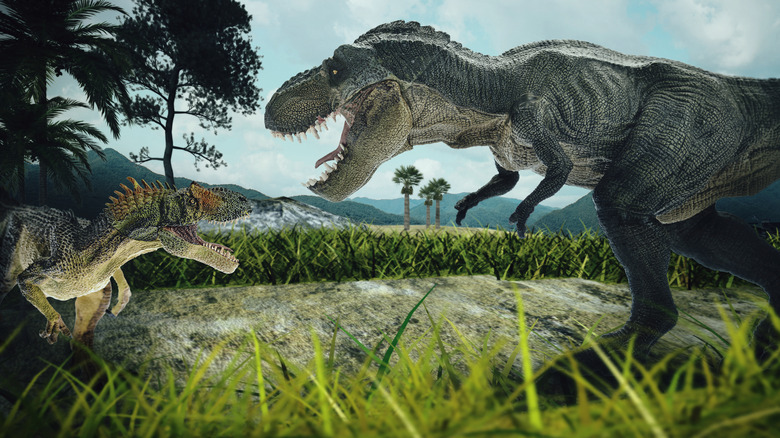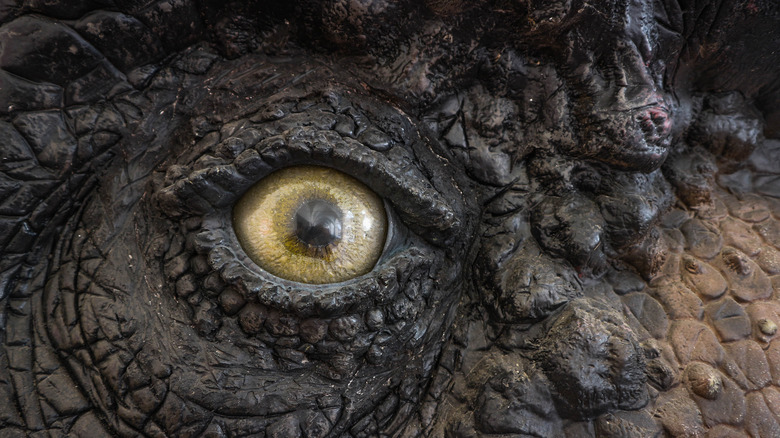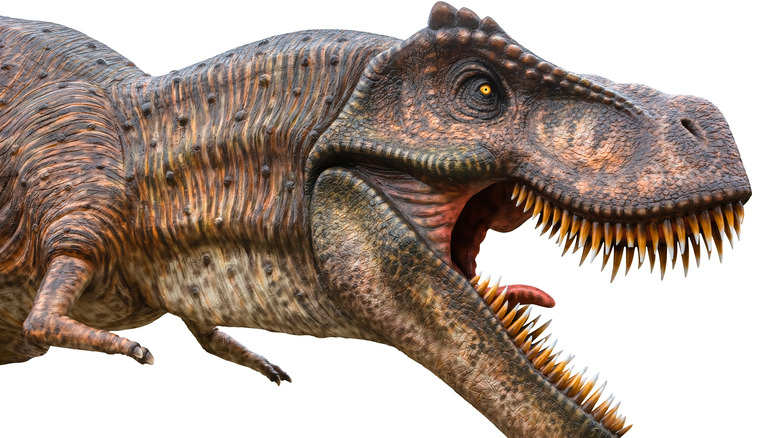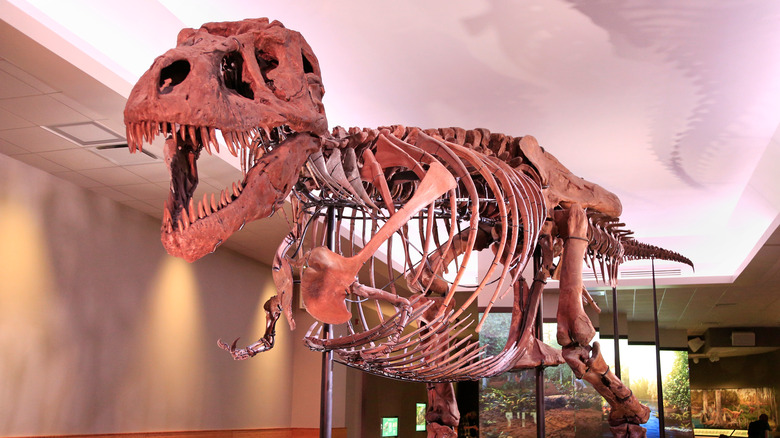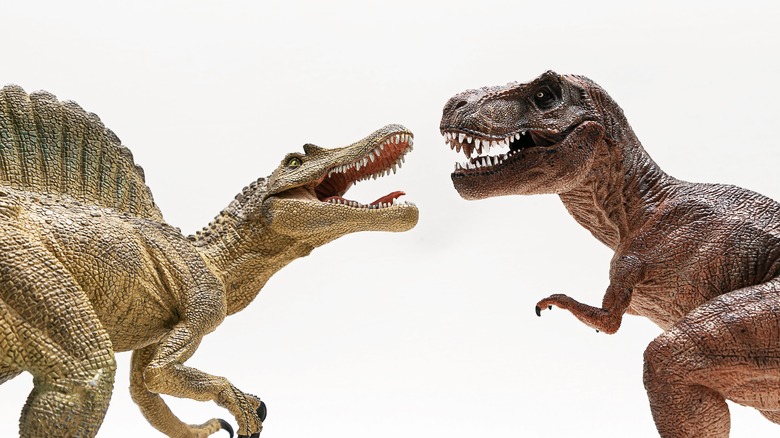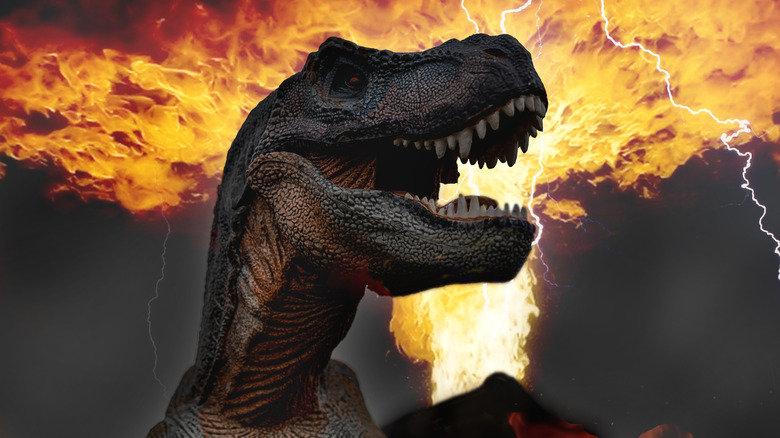The Untold Truth Of Tyrannosaurus Rex
Prominent among the collection at Chicago's Field Museum is specimen FMNH PR 2081, better known as Sue. Sue, whose sex is unknown, is undeniably compelling, but not just because the fossilized remains are 67 million years old. As a matter of fact, Sue is one of the most complete skeletons in existence of perhaps the most famous prehistoric predator of all, Tyrannosaurus rex (often referred to as T. rex).
Tyrannosaurs were a group of predatory dinosaurs from the Cretaceous Period. According to Britannica, while most were large, the species Tyrannosaurus rex, or "king of the tyrant lizards," was one of the biggest. How big? National Geographic shows this predator was as big as a bus, with a massive head and teeth about as big as bananas. The whole T. rex predatory package is so well-known that they have been a staple in countless feature films over the decades, from "King Kong" to "Jurassic Park."
Interestingly, T. rex also happens to be one of the most well-studied dinosaurs. It is for this reason that we know more about T. rex than most other prehistoric species. So let's step into our time machine and go back to over 60 million years ago, when mammals were scurrying around underfoot while dinosaurs ruled the Earth.
They existed near the end of the dinosaurs' reign
Time is perspective. According to the American Museum of Natural History, Tyrannosaurus rex lived during the Late Cretaceous, which lasted from 90 to 66 million years ago. It was during this time when T. rex stalked plant-eating dinosaurs like Triceratops and Edmontosaurus. Meanwhile, the entirety of the Mesozoic Era, which is generally considered to be synonymous with the age of dinosaurs, began 251 million years ago. What this means is that dinosaurs were the dominant form of animal for quite some time — and that many dinosaurs came and went extinct long before T. rex.
For example, one of the most recognizable dinosaurs is the plated and spike-tailed Stegosaurus. Britannica tells us that this dinosaur and many of its relatives lived from about 159 to 144 million years ago, during the Jurassic period. This was over 107 million years before T. rex. To put it another way, modern-day humans are closer in time to T. rex than T. rex was to Stegosaurus.
Thus, the truth of the matter is that when we think of T. rex, we should think of it as one kind of animal from a specific age during which there were still a few (but certainly not all) of the other dinosaurs that children and adults know and love today.
They grew at alarming rates, especially as teens
Not much is known about Tyrannosaurus rex parental care, but fossil evidence strongly suggests that these beasties grew incredibly fast and in spurts.
Just how this is known is explained by the Field Museum. Bones, like trees, can be cut in half and examined for rings, which show the age of the animal. The thickness of the rings shows how fast it grew. When researchers looked at a cross section of the core of Sue's thighbone, they determined that T. rex's young experienced an immense growth spurt during adolescence. Considering the fact that these animals grew to be 16,000 pounds, it makes one wonder just how fast these meat-eaters leapt from hatchling to adult. Per estimates, they likely gained 30 to 45 pounds per week during these spurt periods, until reaching their adult size at about age 20.
Curiously, a cousin group of the tyrannosaurs called the allosauroids grew more slowly and steadily through life. One theory to explain the difference is that the typical mainstays on T. rex's menu (such as hadrosaurs and ceratopsians) also saw adolescent growth spurts. This was just their way of keeping up.
They probably had feathers and lost them
One common point of debate about Tyrannosaurus rex is whether or not it had feathers. The realization that many dinosaurs had feathers is from recent decades and confirmed through fossil evidence. It is widely known that birds today are members of the theropod dinosaur group whose largest member is T. rex (per Bird Life International). However, does this mean that T. rex looked like a mutant chicken on the world's most potent steroids?
The answer is still being debated. Reporting on a show at the American Museum of Natural History, the New York Times mentions that T. rex young had feathers, which they shed as they reached maturity. This argument is supported by confirmed feather impressions in fossils of other tyrannosaur species. The Smithsonian supports this case, stating that adult specimens were more scaly than feathery, though they may have had feathery plumage on the back.
The likely reason for the sparse plumage as an adult has to do with heat. Large animals like T. rex do not need as much insulation to keep warm. In addition, bearing feathers would make it hard to cool down after running after prey. However, this is mainly speculative. Because feathers are soft tissues, they are more difficult to fossilize than bone. Perhaps a new finding will show us once and for all if T. rex truly was like a giant chicken.
Their teeth were no joke
It is well known that Tyrannosaurus rex's teeth were formidable. National Geographic explains that the animal had a set of 60 serrated teeth about 8 inches long. While one can conclude that these teeth were likely T. rex's main weapon, there are several theories on exactly how they were used.
"Dinosaurs of Italy" posits that tyrannosaur teeth were shaped in such a way that bits of meat easily lodged in them. Since T. rex didn't have dental floss, their teeth became a breeding ground for nasty bacteria. Thus, it's possible that a T. rex bite infected the victim. The Komodo dragon, for instance, can nip its victim, then follow it as it succumbs to a painful microbial death. T. rex may have hunted in a similar way.
Then again, T.rex could also just bite and kill its prey. Per Smithsonian Magazine, T. rex had the most powerful bite of any land animal that ever existed. Computer models show that the creature may have had a bite force of 12,800 pounds per square inch — exponentially more powerful than anything alive today (for example, crocodiles have a bite force of 3,700 pounds per square inch).
With such power, the T. rex could chomp through... anything, really. Muscles, bones, and organs would be turned into mashy pulp with ease. The secret behind this super-strong bite? T. rex's stiff lower jaw, which braced its entire head (via Science News).
They ate like crocodiles
Though Tyrannosaurus rex's teeth may look and seem impressive, they also had limitations. While they were great for catching and killing prey, they weren't exactly designed for chewing. Additionally, T. rex had tiny arms that couldn't even reach its mouth (more on that later). But if that were the case, then how was this predator supposed to feed? Did it just dive headfirst into a carcass in an orgy of gruesome gore like a vulture, or did it use some other method?
National Geographic tells us that T. rex grabbed the flesh of its meals with its teeth and stripped off pieces of meat and bone using its powerful neck muscles. It likely threw its head back and tossed chunks of flesh and bone to the back of its mouth, in a process called "inertial feeding." To get a clearer idea of what this looks like in action, imagine how a large bird (like an eagle or stork) or an alligator or crocodile eats. T. rex most likely ate in the same way, which is reasonable since birds and T. rex belong to the same group.
They may have been an invasive species
Paleontologists had traditionally placed Tyrannosaurus rex as being native to North America. As explained by the American Museum of Natural History, it was in the Hell Creek Formation of Montana where the famous fossil hunter Barnum Brown discovered the first specimen of T. rex in 1902. However, the reality is a bit more complicated.
Live Science reports that recent studies based on close analysis of the characteristics of tyrannosaur fossils suggest that the family may have first evolved in Asia. The theory goes that tyrannosaurs evolved on the supercontinent of Pangaea, which began to break up about 100 million years ago. The tyrannosaur that became T. rex may have evolved first in Asia, after which the species may have migrated across the land connection between Asia and North America about 67 million years ago (when sea levels were low).
Curiously, other tyrannosaurs in North America went extinct at roughly the same time. If the theory is true, then T. rex may have outcompeted all the other large tyrannosaurs that were actually native to North America.
They were both scavengers and hunters
In paleontological circles, there is a long-standing debate about whether Tyrannosaurus rex was a mighty hunter or a lonely scavenger. National Geographic outlines the argument. On one hand, T. rex was just so large and powerful — and fossil evidence shows so many injuries to the skeletons of these beasts — that they must have actively hunted for a living.
However, those on the other side of the argument counter that because T. rex was so huge and frightening an adult, an individual could force any other predator off of its kill. To some, T. rex, though impressive, was not exactly an ideal predator, with its apparent lumbering gait and tiny, seemingly useless arms. That, coupled with large olfactory lobes, made it evident that the animal may have been designed for finding prey that had already been killed.
In the end, the truth of the matter seems to be that T. rex was a bit of both. Fossils of hadrosaurs, a major prey item on the T. rex menu, showed fused tail vertebrae. After analysis, they appeared to hint at wounds that healed after attacks from a T. rex. It is more than likely that T. rex hunted when it wanted and scavenged when it wanted. It was, after all, at the top of the Cretaceous food chain.
They were likely cannibals
With virtually anything and everything on its menu, some evidence suggests that Tyrannosaurus rex often turned on one another for a snack.
The research article "Cannibalism in Tyrannosaurus rex," which is about as straightforward a title as one could wish for, explains how T. rex bones bore tooth marks of large predatory dinosaurs. These tooth marks resemble the "puncture and pull" marks left by tyrannosaurs. Other large predators such as crocodiles would not have left such marks. Since there are no other large theropods where T. rex lived, it is believed that these marks are evidence of cannibalism. What's more, the researchers believe that this type of behavior must have been common, since a large sample of the fossils studied had the tooth scarring.
This did not mean, however, that T. rex hunted each other in epic battles. On the contrary, the researchers believe that the type of bite marks show feeding habits that indicate scavenging. In other words, if T. rex came upon a dead T. rex, it wasn't going to pass up a free meal. They concluded that T. rex was an "indiscriminate and opportunistic feeder, feeding not only on herbivorous dinosaurs, but also on members of its own species." This is comparable to the relatively high rate of cannibalism among modern predatory animals such as hyenas, large cats, bears, and crocodilians.
They had top-notch senses
Tyrannosaurus rex just did not have an immense size and a car-crushing bite. According to the American Museum of Natural History, T. rex likely also had outstanding senses that would have helped it find prey or locate a carcass.
For example, T. rex had a great sense of smell. National Geographic relates how studies of T. rex's brain cavity as well as comparative genetic research reveal that it probably had a sense of smell almost as sensitive as that of a housecat's. Perhaps T. rex's keenest sense was its sight. Noted paleontologist Jack Horner once described T. rex's eyes as "beady." But as the "Tyrannosaur Chronicles" notes, this was not the case. The creature's eyes were as big as oranges, which made them the largest eyes of any land animal of any time. The perception of T. rex's beady eyes is probably a problem of scale; after all, if you were to hold up any fruit against its massive skull, the fruit would certainly look tiny.
Furthermore, T. rex's eyes were set forward,providing depth perception. This made it possible for T. rex to know just how far away from its jaws its next meal was. It is also theorized that since birds and crocodilians can see to the ultraviolet spectrum, so could T. rex.
You could outrun one if you were in shape
One of the most disconcerting parts of Stephen Spielberg's 1993 film "Jurassic Park" features an escaped Tyrannosaurus rex running after one of the Park's jeeps at full gallop. "Jurassic Park" did much to dispel the old notion that dinosaurs were slow-moving, lumbering beasts, depicting them as fast-moving and possibly warm-blooded creatures. But was T. rex really as fast as it was in the film?
The truth is that T. rex, while not lumbering, was no cheetah. The Royal Society published a study that examined how fast T. rex would walk based on 3-D modeling of the dinosaur's tail. They concluded that the maximum speed it could reach was a little under 3 miles an hour. As for when it was running, Live Science reports that it was probably able to reach somewhere from 10 to 25 miles per hour. However, this is still being debated, since it is not clear how much the tail acted as a shock absorber. That said, it does seem that you could outrun a T. rex on your own (provided, of course, that you've been doing at least some degree of cardio regularly).
Their arms are unexplainable
The most commonly mocked feature of Tyrannosaurus rex are its puny, 3-foot-long arms. To put this in perspective, if a 6-foot man had comparatively T. rex-sized arms, they would be about 5 inches long. In his comic strip "The Far Side," Gary Larson depicted a T. rex family at the dining table, unable to pass the potatoes due to their short arms. But surely these appendages were useful in some ways, right?
The truth is, nobody really knows what T. rex's arms were good for. In fact, Discover Magazine reports that upon his discovery of the first T. rex fossil, Barnum Brown thought the arms belonged to a different animal. Realizing his mistake, he proposed that the arms were used by males to hold females during mating, despite both sexes having puny arms. Some scientists viewed the limbs as vestigial, just as how wings shrink in some flightless birds.
Other scientists have noted that while tiny, the arms were in fact pretty powerful, and could be used to slash at prey when at very close quarters. As History.com points out, these claws were razor-sharp, and could inflict several severe gashes while a T. rex was on a victim's back. A more recent theory is that T. rex's arms shrank over time, in order to avoid accidental amputation at kill sites where other T. rex may have been gorging themselves on a carcass. The debate will no doubt continue.
They lived hard and died young
Tyrannosaurus rex was at the top of the ecosystem, but the truth is that it lived a very rough life brought about by its predatory lifestyle.
For example, New Scientist reports that Sue the T. rex had extensive injuries. Both of her ribs had been broken and rehealed. It is believed that these cracked ribs occurred while struggling with prey. Moreover, Sue's arm and leg bones show that the dinosaur had also recovered from infections.
Furthermore, according to LiveScience, Sue likely had a debilitating tooth infection until death, as two of the dinosaur's teeth were fused together. This may have been caused by a prior oral infection (probably parasitic in nature) in the jaw. As teeth were unsurprisingly the most important tool in T. rex's survival kit, adults grew new replacement teeth every one to two years. However, Sue's infection may have been a chronic condition, and that the animal probably died in pain at the age of 28. Incidentally, this makes Sue the oldest known specimen of T. rex (via the Field Museum). It is also likely that Sue suffered from arthritis.
They weren't the largest carnivorous dinosaur
While Tyrannosaurus rex's name means "tyrant lizard king," this king wasn't exactly the biggest predatory dinosaur on the Mesozoic block.
According to Britannica, an adult T. rex grew up to 46 feet long from head to tail, and weighed around 15,000 pounds. While that's undeniably pretty big, Live Science reports that Spinosaurus was bigger. Scientists are still debating its exact size (as they based it on just partial fossil remains), but one estimate places Spinosaurus at a maximum length of 50 feet and weighing upwards of 46,000 pounds. Spinosaurus also featured a dorsal spine (hence the name), plus an elongated skull with needle-like teeth. This has led some to believe that this creature was semi-aquatic or aquatic, hunting fish in rivers or scavenging.
So who would win in a fight between T. rex and Spinosaurus? It is all speculative, since Spinosaurus lived 112 to 97 million years ago, arriving on (and disappearing from) the scene well before T. rex. The two didn't even exist in the same region — Spinosaurus lived in the swamplands of what is now North Africa.
Another massive predator that lived before T. rex (and was slightly larger than it) was Giganotosaurus, which clocked in at approximately 28,000 pounds. This theropod existed at the same time as Spinosaurus, but it lived in South America, so their paths never would have crossed.
The last one probably starved to death
Tyrannosaurus rex lived at the tail end of the Cretaceous period. This means that T. rex likely witnessed — and was a direct victim of — the most famous mass extinction event in history, the Cretaceous-Tertiary (K-T) extinction.
As Britannica explains, the K-T extinction is named after the boundary between the Cretaceous and subsequent Tertiary period in the geologic record. This event proved to be the end not just of T. rex, but of countless other species it co-existed with. Per National Geographic, the leading theory behind what caused the extinction event is that a meteor struck the planet at the end of the Cretaceous, setting off a global disaster that choked the skies with dust and debris. This led to environmental collapse and the demise of most species on earth, although some theropod dinosaurs managed to live on as the birds of today. Other theories posit that massive eruptions in the Deccan traps in India set off the cataclysm. It may have been a combination of both.
Either way, the last Tyrannosaurus rex likely lived in a damaged hellscape, with the food web it depended on for millions of years collapsing. Indeed, it may have been starvation that sealed the fate of the last T. rex.
